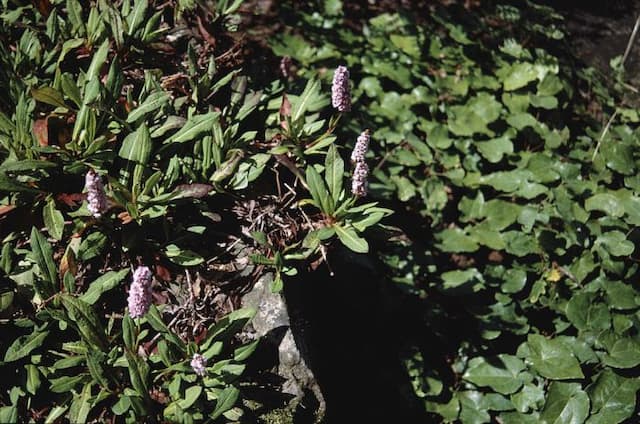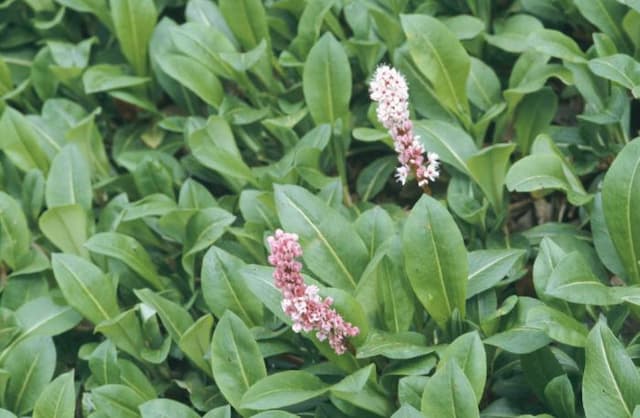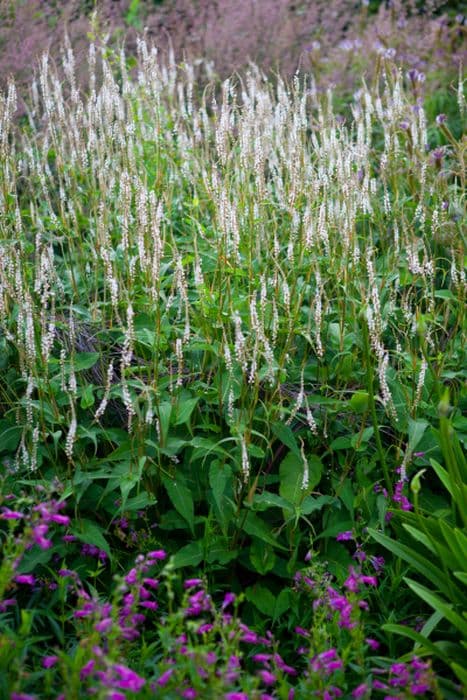Red bistort Persicaria amplexicaulis 'Dikke Floskes'

ABOUT
The plant known as Persicaria amplexicaulis 'Dikke Floskes' has distinctive features that contribute to its appearance. The leaves are broad and somewhat heart-shaped, attaching to the stem in a manner that appears to clasp it, hence the name "amplexicaulis," meaning "embracing the stem." These green leaves form a dense, lush clump and can have a slightly puckered texture. The most striking feature of 'Dikke Floskes' is its blooms. During the flowering season, it produces a profusion of small flowers on slender, wand-like spikes that rise above the foliage. These flowers are typically a deep, rosy-pink color that adds a bright splash of color to garden settings. The individual blossoms are tiny and densely packed along the spikes, creating a feathery appearance. Overall, the plant has a bushy, spreading habit which contributes to its full, robust look. Its flowers are attractive to a variety of pollinators, including butterflies and bees, making it not only a beautiful garden choice but also beneficial for supporting local ecosystems. The rich green foliage contrasts well with the vivid pink flowers, making it a popular choice for gardeners who want to add long-lasting color to their landscapes.
About this plant
 Names
NamesFamily
Polygonaceae
Synonyms
Red Bistort, Bistort, Mountain Fleece, Fleeceflower
Common names
Bistorta amplexicaulis, Persicaria amplexifolia, Polygonum amplexicaule.
 Toxicity
ToxicityTo humans
Mountain fleece (Persicaria amplexicaulis 'Dikke Floskes') is generally not considered toxic to humans. There is limited information available regarding severe toxicity or poisoning from ingesting this plant. However, as with many plants, individual sensitivity can vary, and ingesting plant material may cause gastrointestinal discomfort or an allergic reaction in some people. It is advisable to avoid eating any part of ornamental plants unless they are known to be edible.
To pets
Mountain fleece (Persicaria amplexicaulis 'Dikke Floskes') is typically not toxic to pets. There is no significant evidence to suggest that this plant causes serious poisoning in animals. Nevertheless, ingestion of plant materials may lead to gastrointestinal upset, such as vomiting or diarrhea, especially if the pet is not accustomed to eating such material or if it consumes a large amount. As a general precaution, it is wise to prevent pets from ingesting ornamental plants.
 Characteristics
CharacteristicsLife cycle
Perennials
Foliage type
Deciduous
Color of leaves
Green
Flower color
Red
Height
3-4 feet (0.9-1.2 meters)
Spread
2-3 feet (0.6-0.9 meters)
Plant type
Herb
Hardiness zones
5
Native area
Himalayas
Benefits
 General Benefits
General Benefits- Attracts Pollinators: Persicaria amplexicaulis 'Dikke Floskes', commonly known as mountain fleece, attracts bees, butterflies, and other beneficial insects, enhancing pollination.
- Drought Tolerance: Once established, mountain fleece is quite drought tolerant, making it suitable for drier climates or water-wise gardens.
- Long Blooming Period: It has a prolonged blooming period, often from midsummer to late fall, providing consistent color in the garden.
- Low Maintenance: Mountain fleece requires minimal upkeep once established, making it an easy choice for gardeners of all levels.
- Deer and Rabbit Resistance: The plant is generally resistant to deer and rabbits, which can help reduce damage in the garden.
- Ornamental Appeal: With its tall, wand-like flower spikes of reddish-pink blossoms, it adds vertical interest and a splash of color to any planting.
- Erosion Control: The sturdy root system of mountain fleece can help stabilize soil and prevent erosion on slopes or banks.
- Non-Invasive: Unlike some other species in the Persicaria genus, mountain fleece is non-invasive, making it a responsible choice for gardeners.
- Adaptable: It adapts to a wide range of soil conditions, though it prefers moist, fertile soils, enhancing its versatility in landscaping.
- Seasonal Interest: Its foliage often changes color in the fall, providing additional seasonal interest to the garden landscape.
 Medical Properties
Medical PropertiesThis plant is not used for medical purposes.
 Air-purifying Qualities
Air-purifying QualitiesThis plant is not specifically known for air purifying qualities.
 Other Uses
Other Uses- Floral arrangements: The long-lasting blooms of Persicaria amplexicaulis 'Dikke Floskes' can be cut and added to bouquets and arrangements for a touch of unique color and texture.
- Natural dye: The flowers and leaves can potentially be used to create natural dyes for textile coloring, though experimentation may be needed to determine the exact color and fastness.
- Educational tool: The plant can be used in educational settings such as botanical gardens to demonstrate plant growth habits and pollinator attraction in a garden setting.
- Artistic inspiration: Artists may use the form and color of the 'Dikke Floskes' variety as inspiration for paintings, drawings, and other artistic works.
- Insectary plantings: It can be incorporated into garden designs aimed at attracting and supporting beneficial insects.
- Culinary decoration: Although not commonly consumed, the vibrant flowers might be used as a decorative element for plating in high-end culinary presentations.
- Photography subject: The striking appearance of 'Dikke Floskes' provides a rich subject for photographers specializing in botanical and garden photography.
- Cultural festivals: The plants can be used as part of garden exhibits for cultural events and garden festivals, showcasing its ornamental appeal.
- Permeable landscaping: The dense growth habit can be part of permeable landscaping designs that aim to reduce runoff and improve water absorption.
- Seasonal interest: In landscape design, it can provide a valuable source of late-season color when many other plants have finished flowering.
Interesting Facts
 Feng Shui
Feng ShuiThe Red bistort is not used in Feng Shui practice.
 Zodiac Sign Compitability
Zodiac Sign CompitabilityThe Red bistort is not used in astrology practice.
 Plant Symbolism
Plant Symbolism- Abundance: The name 'Dikke Floskes', which translates to 'Fat Spikes', suggests a symbolism related to abundance or plentifulness, given the plant's generous shape and volume of its flower spikes.
- Resilience: Persicaria amplexicaulis, also known as Mountain Fleece, is a hardy plant that thrives in varied conditions, symbolizing the ability to adapt and persevere through challenges.
- Richness: The robust and lush growth of Mountain Fleece can be seen to represent richness, not just in material terms, but also in the fullness of life and experiences.
 Water
WaterFor the Red Bistort 'Dikke Floskes', it is important to maintain consistent moisture, especially during its active growth in spring and summer. Water the plant thoroughly once a week, ensuring that the soil is well-saturated but not waterlogged. During periods of extended dryness or heat, you may need to water twice a week, supplying about 1 to 1.5 gallons per plant per watering session. In cooler temperatures or during the fall, reduce watering frequency to prevent overwatering, giving the plant enough water to keep the soil lightly moist.
 Light
LightThe Red Bistort 'Dikke Floskes' thrives best in full sun to partial shade. It should be placed in a spot where it can receive at least 4-6 hours of sunlight daily. For optimal growth and bloom, a location with morning sun and afternoon shade is ideal to protect it from the intense heat of the late day.
 Temperature
TemperatureThe Red Bistort 'Dikke Floskes' is a hardy plant that can withstand a range of temperature conditions. It prefers temperatures between 50°F to 75°F but can survive in temperatures as low as 20°F and as high as 85°F. Avoiding extreme heat or frost will help maintain its health and vigor.
 Pruning
PruningPruning the Red Bistort 'Dikke Floskes' is beneficial for maintaining its shape and encouraging new growth. Trim back spent flower stems and deadhead regularly to promote further blooming. A more thorough pruning should be done in early spring to remove any old, dead foliage and to shape the plant for the coming season. Pruning is typically needed once a year.
 Cleaning
CleaningAs needed
 Soil
SoilRed bistort 'Dikke Floskes' prefers moist, well-drained soil rich in organic matter with a pH range of 5.5 to 7.0. A soil mix for this plant can consist of garden soil, compost, and peat moss to ensure good drainage and fertility.
 Repotting
RepottingThe red bistort 'Dikke Floskes' is not typically grown in containers and therefore does not require frequent repotting. It is a perennial that is best planted directly in the garden soil.
 Humidity & Misting
Humidity & MistingRed bistort 'Dikke Floskes' is adaptable to a range of humidity conditions and does not require any special humidity requirements. It thrives in outdoor settings where the natural humidity is adequate.
 Suitable locations
Suitable locationsIndoor
Keep in bright indirect light, ensure good air flow, and use moist soil.
Outdoor
Plant in partial shade, keep soil moist, protect from strong winds.
Hardiness zone
4-7 USDA
 Life cycle
Life cyclePersicaria amplexicaulis 'Dikke Floskes', commonly known as Red bistort or Mountain fleece, begins its life cycle as a seed that germinates in cool, moist soil during the spring. Once germinated, it develops into a seedling with tender leaves that continue to mature into a robust herbaceous perennial with thick, leafy stems. As it grows, the plant forms a bushy clump with large, ovate leaves along its stems. By midsummer to early autumn, the Red bistort produces tall, dense spikes of tiny, rich pink or red flowers that are attractive to bees and butterflies. Following the flowering stage, seeds are produced and disseminated, ensuring the spread of new plants for the next growing season. Finally, in winter, the top growth dies back, but the plant's root system remains alive underground, allowing it to resprout when conditions become favorable in the following spring.
 Propogation
PropogationPropogation time
Spring-Early Summer
The most popular method of propagating Persicaria amplexicaulis 'Dikke Floskes', commonly known as Mountain Fleece, is by division. This is typically done in the spring as new growth appears or in the early fall, when the plant's vigorous growth slows down giving it time to establish before the onset of winter. To propagate by division, gently dig up the clump of the parent plant and separate it into smaller sections, each with a portion of roots. It's important to ensure that each division has at least one shoot for successful reestablishment. After dividing, replant the sections at the same depth they were growing originally, spacing them about 15 to 18 inches (approximately 38 to 46 centimeters) apart, and water well to help settle the soil around the roots. This method allows gardeners to rapidly increase their stock of Mountain Fleece while maintaining the health and vigor of their existing plants.





![Red bistort [Taurus]](/_next/image?url=https%3A%2F%2Fplants-admin.emdemapps.com%2Fimages%2Fplants%2F%2Fimages%2F604b548be7841.png&w=640&q=75)



